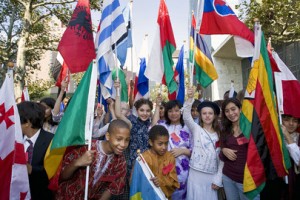Lubetkin’s participation high-lights the importance of the press in creating peace culture through its role as both documenters and public opinion makers.
Realising that importance, IPS has run a number of [...]]]>

Young students in traditional dress waive their national flags during the observance of the International Day of Peace at United Nations headquarters in 2007 | UN Photo/Paulo Filgueiras
IPS’ General Director Mario Lubetkin is about to speak at the U.N. High-level Forum on a Culture of Peace in New York today.
Lubetkin’s participation high-lights the importance of the press in creating peace culture through its role as both documenters and public opinion makers.
Realising that importance, IPS has run a number of stories focusing on peace building at both the community and political level in the weeks leading up to the Forum, including two yesterday that take a closer look at our own role as journalists.
Constanza Vieira’s story on the state of the press in Colombia is an interesting one, as it’s a tale of caution on how long-term national conflict and close ties between the press and government can severely influence the tone of a national media establishment and limit the ability of critical journalists to counter ingrained hard-line narratives.
“One problem was that the media in [Colombia] had turned ‘peace’ itself into a dirty word”, she said, explaining how a shift is only gradually happening through the blogosphere in Colombia.
Instead of “spreading the poison,” journalists need to be trained to fulfill their obligation to provide context that helps “feelings turn into logic,” according to a Colombian journalist in Vieira’s story.
In an interview with IPS’ Rousbeh Legatis, Tarja Turtia, programme specialist at UNESCO’s Division for Freedom of Expression, affirms the importance of the media and particularly blogs in post-conflict states in “starting debates that could not be initiated openly before.”
She also stressed the importance of strong community media in countries like Sierra Leone, in preventing conflict by providing accurate and timely information to remote areas via radio, which UNESCO supports through its International Programme for the Development of Communication.
Since media pluralism is widely acknowledged as part of peace building, I should also mention the importance of self-representation in changing encrusted narrative and tip a hat organizations like Viva Favela in Brazil, who have created a platform for residents of urban slums across the country to tell their own stories as alternative to the often negative media representation that “moradores” experience.
Like Viva Favela, in the U.S. local public access T.V. channels like Manhattan Neighborhood Network here in New York actively built dialogues in communities and empower residents to become media makers and instigators of positive change in their neighborhoods.
Providing a platform for “slow” stories on peaceful resolution of conflicts and acts of community building in today’s rather cynical age of “if it bleeds it leads” has almost become an act of defiance.
But then, peaceful defiance has always been an essential part of opposing war.
]]>This begs the question: what exactly is it?
As my lead suggests, it’s not the first [...]]]>
 This week, as minds here in New York and elsewhere are inevitably drawn back to 9/11 and its aftermath, the U.N. General Assembly (GA) will once again discuss the worldwide promoting a Culture of Peace.
This week, as minds here in New York and elsewhere are inevitably drawn back to 9/11 and its aftermath, the U.N. General Assembly (GA) will once again discuss the worldwide promoting a Culture of Peace.
This begs the question: what exactly is it?
As my lead suggests, it’s not the first time the topic has passed our U.N. news desk.
Spearheaded by UNESCO, United Nations Educational, Scientific and Cultural Organization, 2000 became the U.N. Year for a Culture of Peace. For those who missed it, the GA doubled down on the concept a year later by declaring a Decade of the Culture of Peace (2001-2010) in which it took a stab at involving civil society in creating a global movement for peace culture.
75 million people signed a 2000 Manifesto pledging their support – Meanwhile, a quick survey among my friends revealed that, unfortunately, none knew of it.
“Peace is the absence of war” continues to be an evergreen. But how exactly do you create a culture in which war is absent? What is a Culture of Peace?
In a 1999 resolution and Programme of Action prepared by UNESCO, the GA agreed on eight elements of a Culture of Peace.
Here’s a little overview, drawn from the ’99 resolution and various works of David Adams, former Director of the UNESCO Unit for the Year of a Culture of Peace and an expert on the brain mechanism of aggression.
1. Education for Peace
Since warfare is a learned behaviour, according to Adams, a key component to building a Culture of Peace is a shift from an authoritarian and war-centric educational tradition to a participatory education on values and modes of behaviour that allow youth to resolve disputes non-violently and with respect for human dignity.
This education ought to take place not only in schools, but include informal education taking place through the family and the media, as well as non-governmental and community organizations.
2. Understanding, tolerance and solidarity
The act of “othering” people and designating an enemy is a key component to warfare and detrimental to a Culture of Peace.
Instead, the U.N. and social institutions at all levels ought to foster dialogue and actions that build mutual understanding, tolerance and solidarity.
3. Democratic participation
Hierarchical structures and authoritarianism that are at the centre of warfare ought to be replaced with people’s democratic involvement at all levels of decision-making affecting their lives.
In addition to stronger education on democratic principles, the resolution mentions capacity-building of public officials to strengthen institutions and processes that promote democracy.
4. Free flow of information and knowledge
A strong and free media is essential to documenting and promoting peace culture, while networks are essential social infrastructures.
Propaganda and secrecy, on the other hand, are essential to maintaining public approval for warfare. A free flow of information is thus essential to building a culture of peace in which an informed population is able to exercise its democratic rights to voice disapproval of acts of aggression.
5. Equality of women and men
Male domination is a central part of the culture of war, according to Adams, not because of a genetic disposition to warfare, but because of the age-old initiation of men into war and women’s systematic exclusion from it.
A transformation to a Culture of Peace therefore requires power sharing and the equal participation of women in decision-making.
6. Sustainable human development for all
Building secure livelihoods and the ability to lead healthy productive lives are key to building and maintaining peace.
Debt relief for developing countries, post-conflict reconciliation processes, and a special focus on the needs of women and children in developing strategies are listed as state-based contributions to a Culture of Peace.
7. Disarmament
While this may seem like a no-brainer, disarmament was actually among the last two items to be added to the action agenda, which originally only had six points.
It finally made it in under the header “Actions to promote international peace and security”, with complete disarmament as the top action item.
8. Respect for human rights
Respect for human rights as an essential component of peace culture encompasses many of the above points and should need little explanation.
Among the action items, the U.N. declaration sought the full implementation of the 1993 Vienna Declaration and the development national programmes and institutions to protect human rights.
]]>